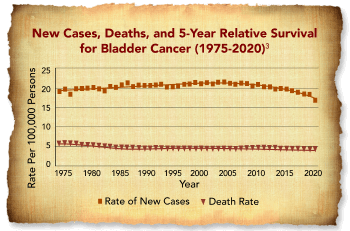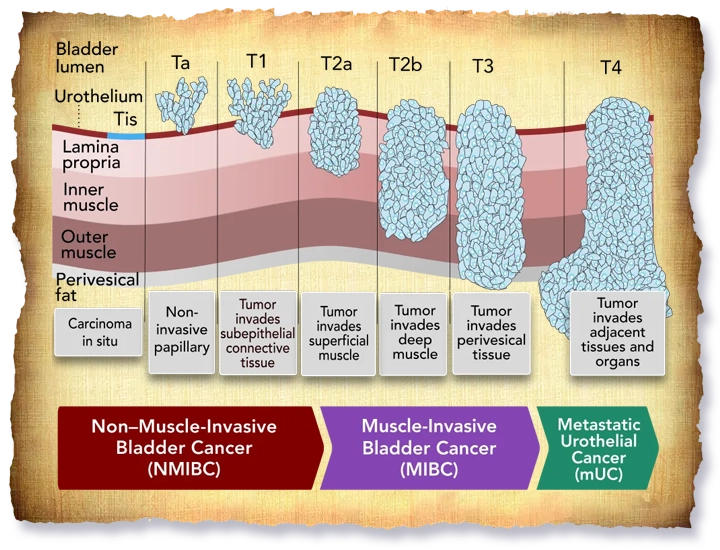Epidemiology of Bladder Cancer IN THE UNITED STATES
- It is estimated that approximately 83,200 new cases of bladder cancer will be diagnosed in 20241
- Bladder cancer is the 6th most common cancer2
mortality due to Bladder cancer in the United States



The Development and Progression of Bladder Cancer
Bladder cancer typically develops in the urothelium and can spread to the bladder muscle, eventually leading to metastasis4-6

- Exophytic papillary tumors that are confined largely to the mucosa (Ta) (70%-75%) or, less often, to the lamina propria (T1) (20%-25%) or flat high-grade lesions (Tis or CIS [carcinoma in situ]) (5%-10%)8
- CIS is a flat non-papillary cancer confined to the urothelium. It is a high-grade form of NMIBC, which can lead to MIBC and quickly spread to mUC8,9
- Enhanced cystoscopy techniques (eg, blue light cystoscopy) can help improve detection and assist in resection, thereby helping to reduce residual tumor10
- CIS may be difficult to resect using transurethral resection of bladder tumor (TURBT) due to its diffuse nature11
- In MIBC, tumors have invaded the bladder muscle with or without lymph node involvement1
- Locally advanced tumors may have spread to nearby organs1
- mUC includes tumors that have disseminated to distant organs such as the lungs, liver, or bone1
References:
Bladder cancer. American Cancer Society. Accessed February 13, 2024. https://www.cancer.org/cancer/types/bladder-cancer.html
Bladder cancer treatment (PDQ®)—health professional version. National Institutes of Health: National Cancer Institute. Updated January 18, 2023. Accessed February 13, 2024. https://www.cancer.gov/types/bladder/hp/bladder-treatment-pdq#_1
Cancer stat facts: bladder cancer. National Cancer Institute: Surveillance, Epidemiology, and End Results Program. Accessed February 13, 2024. https://seer.cancer.gov/statfacts/html/urinb.html
Saginala K, Barsouk A, Aluru JS, Rawla P, Padala SA, Barsouk A. Epidemiology of bladder cancer. Med Sci (Basel). 2020;8(1):15. doi:10.3390/medsci8010015
Kanmalar M, Abdul Sani SF, Kamri NINB, et al. Raman spectroscopy biochemical characterisation of bladder cancer cisplatin resistance regulated by FDFT1: a review. Cell Mol Biol Lett. 2022;27(1):9. doi:10.1186/s11658-022-00307-x
Batista R, Vinagre N, Meireles S, et al. Biomarkers for bladder cancer diagnosis and surveillance: a comprehensive review. Diagnostics (Basel). 2020;10(1):39. doi:10.3390/diagnostics10010039
Grabe-Heyne K, Henne C, Mariappan P, Geiges G, Pöhlmann J, Pollock RF. Intermediate and high-risk non-muscle-invasive bladder cancer: an overview of epidemiology, burden, and unmet needs. Front Oncol. 2023;13:1170124. doi:10.3389/fonc.2023.1170124
Referenced with permission from the NCCN Clinical Practice Guidelines in Oncology (NCCN Guidelines®) Bladder Cancer V3.2024. © National Comprehensive Cancer Network, Inc. 2024. All rights reserved. Accessed April 22, 2024. To view the most recent and complete version of the guideline, go online to NCCN.org. NCCN makes no warranties of any kind whatsoever regarding their content, use or application and disclaims any responsibility for their application or use in any way.
Bladder cancer: stages and grades. Cancer.net. Accessed February 14, 2024. https://www.cancer.net/cancer-types/bladder-cancer/stages-and-grades
Elferink PO, Witjes JA. Blue-light cystoscopy in the evaluation of non-muscle-invasive bladder cancer. Ther Adv Urol. 2014;6(1):25-33. doi:10.1177/1756287213510590
Kim LHC, Patel MI. Transurethral resection of bladder tumour (TURBT). Transl Androl Urol. 2020;9(6):3056-3072. doi:10.21037/tau.2019.09.38
Patel VG, Oh WK, Galsky MD. Treatment of muscle-invasive and advanced bladder cancer in 2020. CA Cancer J Clin. 2020;70(5):404-423. doi:10.3322/caac.21631